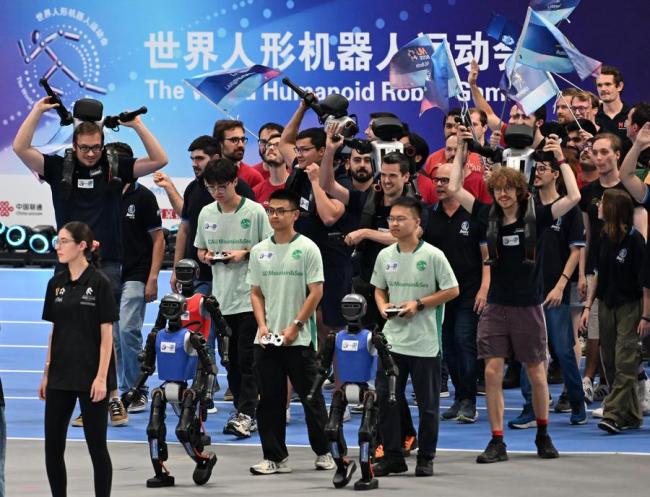Xinhua Headlines: Humanoid robot games in China spotlight global tech innovation
During the opening ceremony, the 14-year-old flag bearer from a junior high school in Beijing became the youngest participating engineer. Three teams composed of junior high school and senior high school students also competed in the soccer events.

The international squad march in the stadium during the opening ceremony of the 2025 World Humanoid Robot Games in Beijing, capital of China, Aug. 14, 2025. (Xinhua/Zhang Chenlin)
Young talents from various countries have been pouring into humanoid robotics development. Most are STEM (Science, Technology, Engineering and Mathematics) enthusiasts or university students majoring in fields like mathematics, mechanical engineering, electronics, computer science, and communications. During the competitions, they troubleshot malfunctioning robots on-site, connecting laptops to adjust software parameters with the precision and focus of a laboratory experiment.
China's talent advantage is a key driver in advancing humanoid robotics. Zhou Changjiu, president of the RoboCup Asia-Pacific Confederation and one of the co-organizers of the games, noted that China has a culture that deeply values STEM education. Both parents and society place great emphasis on STEM, with many children actively participating in competitions, creating a unique cultural and social environment that fosters talent development.
According to policy documents unveiled this May, China will establish a tiered AI education system pning primary, junior high and senior high schools to guide students from foundational cognitive awareness to practical technological innovation.
GLOBAL OPEN PLATFORM
The games also provided a platform for global humanoid robotics researchers to exchange ideas, allowing engineers from various countries to get familiar with the latest robots and refine their algorithms.
In the soccer competition, over 10 international teams from countries including Brazil, Germany, Japan, Malaysia, Australia, Italy, Thailand and Indonesia used T1 robots from Beijing-based Booster Robotics. In the 2025 RoboCup held in Brazil this July, two Chinese teams made history by using these T1 robots, sweeping both the champion and runner-up titles in the adult-size category.

Humanoid robots compete during a 3V3 soccer match at the 2025 World Humanoid Robot Games in Beijing, capital of China, Aug. 15, 2025. (Xinhua/Ju Huanzong)
According to Joao Victor, a soccer team member of RoboFEI from Brazil, it was the first time that he used Booster Robotics T1, and the robots were amazing. His team could talk with other teams from around the world and pick up new tactics from the competition.
Zhao Weichen said Booster Robotics has increased investment in operating systems and all-in-one development tools, making it easier for other users to do secondary development.
Thanks to the modular and readable design, developers can use the integrated development tools to quickly migrate algorithms across different robot brands. For example, at the 2025 RoboCup in Brazil, a German team rapidly deployed their original robot's algorithms onto Booster Robotics K1 and ultimately won the championship in the small-size category, Zhao added.
According to Zhou, the games served as both a platform and a showcase, demonstrating to the world China's advantages in the humanoid robotics sector from the industrial chain and robot hardware to a large user base. It also showed the global developers that by cooperating with China, they can integrate the country's top-tier hardware with their own algorithms to solve diverse challenges.
"I'm truly excited that China is hosting the first World Humanoid Robot Games. It's making history. A decade or two from now, we'll look back and recognize this as the birth of the robot Olympics. Just as the Olympic Games originated in Ancient Greece, future generations will see Beijing as the birthplace of the modern robot Olympics," he said.
■